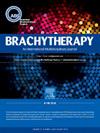患有围手术期或慢性血栓栓塞疾病的妇科近距离放射治疗患者的抗凝管理:回顾性分析。
IF 1.7
4区 医学
Q4 ONCOLOGY
引用次数: 0
摘要
目的:因妇科恶性肿瘤需要手术近距离治疗的慢性抗凝(AC)妇女是一项临床挑战,但目前尚无关于近距离治疗患者选择或其围手术期管理的指南。我们的目的是了解慢性近距离放疗患者出血和栓塞事件的发生率,并提出针对这一患者群体的管理策略:我们对 2013 年至 2023 年接受妇科近距离放射手术治疗的患者进行了一项单一机构的回顾性研究,以确定接受慢性近距离放射治疗的患者。我们确定了使用近距离放疗的适应症、肿瘤治疗特征、近距离放疗中断时间以及治疗结果。主要目的是根据不良事件通用术语标准确定围手术期栓塞或出血并发症:结果:在304名接受手术植入治疗的患者中,有32人(10%)因静脉血栓栓塞(25人)或心房颤动/扑动(13人)而长期服用AC。最常见的恶性肿瘤是宫颈癌(15 例)和无法手术的子宫癌(11 例)。植入方式有腔内植入(14 例)、间质植入(6 例)或混合植入(12 例),每次植入的中位数(范围)为 2(1-3)次植入、4(2-5)次分割和 2(1-3)天卧床休息。63%(n = 20)的患者使用硬膜外麻醉进行镇痛。94%的患者(n = 30)在手术植入前进行了中位 3 天的交流,78%的患者(n = 25)进行了药物性深静脉血栓预防。有两例≥2级出血事件,没有新的栓塞事件:出血和栓塞事件的发生率是可以接受的,不应该将长期服用 AC 的妇女排除在可能挽救生命的手术近距离放射治疗之外,包括需要脊髓镇痛和间歇应用器的复杂病例。本文章由计算机程序翻译,如有差异,请以英文原文为准。
Anticoagulation management in gynecologic brachytherapy patients with perioperative or chronic thromboembolic disease: A retrospective analysis
PURPOSE
Women on chronic anticoagulation (AC) who require operative brachytherapy for gynecologic malignancies represent a clinical challenge, but no guidelines exist regarding patient selection for brachytherapy or their perioperative management. We aimed to understand the incidence of hemorrhagic and embolic events in our patients on chronic AC and suggest management strategies for this patient population.
MATERIALS AND METHODS
A retrospective, single institutional study of patients treated with operative, gynecologic brachytherapy from 2013 to 2023 was performed to identify patients on chronic AC. We determined indications for AC use, oncologic therapy characteristics, duration of AC interruption, and therapy outcomes. The primary aim was to determine perioperative embolic or hemorrhagic complications as measured by the Common Terminology Criteria for Adverse Events.
Results
Of 304 patients treated with operative implants, 32 (10%) were on chronic AC for venous thromboembolism (n = 25), or atrial fibrillation/flutter (n = 13). The most common malignancies were cervical (n = 15) and inoperable uterine (n = 11). Implants were intracavitary (n = 14), interstitial (n = 6), or hybrid (n = 12) with a median (range) of 2 (1-3) implants, 4 (2-5) fractions, and 2 (1-3) days of bedrest per implant. 63% (n = 20) had an epidural for analgesia. AC was held for a median 3 days in 94% (n = 30) prior to the operative implant, and pharmacologic DVT prophylaxis was used in 78% (n = 25). There were two grade ≥ 2 hemorrhagic events and no new embolic events.
Conclusions
The rate of bleeding and embolic events was acceptable, and women on chronic AC should not be excluded from potentially lifesaving operative brachytherapy, including complex cases that require spinal analgesia and interstitial applicators.
求助全文
通过发布文献求助,成功后即可免费获取论文全文。
去求助
来源期刊

Brachytherapy
医学-核医学
CiteScore
3.40
自引率
21.10%
发文量
119
审稿时长
9.1 weeks
期刊介绍:
Brachytherapy is an international and multidisciplinary journal that publishes original peer-reviewed articles and selected reviews on the techniques and clinical applications of interstitial and intracavitary radiation in the management of cancers. Laboratory and experimental research relevant to clinical practice is also included. Related disciplines include medical physics, medical oncology, and radiation oncology and radiology. Brachytherapy publishes technical advances, original articles, reviews, and point/counterpoint on controversial issues. Original articles that address any aspect of brachytherapy are invited. Letters to the Editor-in-Chief are encouraged.
 求助内容:
求助内容: 应助结果提醒方式:
应助结果提醒方式:


